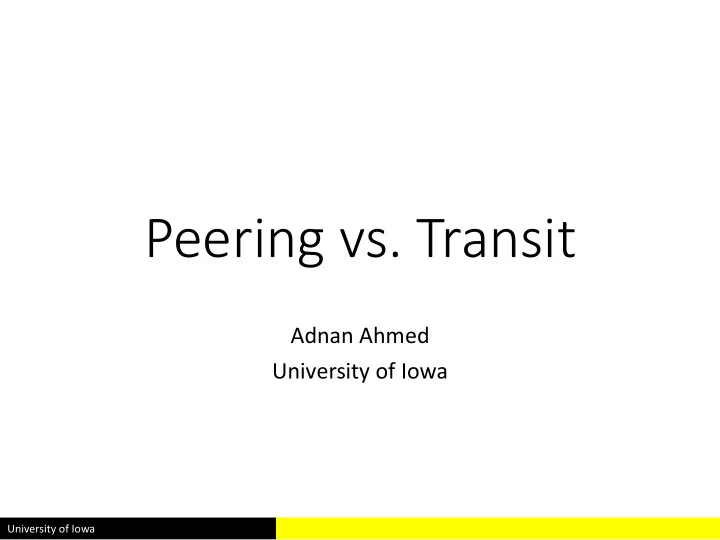

Peering vs. Transit Adnan Ahmed University of Iowa University of Iowa
Introduction • Transit • Provides connectivity to the Internet • Traffic volume based fees • Peering • Bilateral exchange • Settlement-free (no fee) University of Iowa 1. Introduction
Related work Interconnection strategies in peering ecosystem • Agent-based analysis [Lodhi-Dhamdhere, SIGMETRICS ’12] • Open-peering [Lodhi et al., Infocom ’14] • Game-theoretic models [Accongiagioco et al., IFIP ’14][Badasyan-Chakrabarti, Telecommunications Policy ’08] • Complexities in decision making [Lodhi et al., Infocom ‘15] Evolution of peering and topological Impact • Network model [Dhamdhere-Dovrolis, CoNEXT ’10] • Remote peering [Castro et al., CoNEXT ‘14] • IXP study [Ager et al., SIGCOMM ‘12] • PeeringDB analysis [Lodhi et al., SIGCOMM CCR ’14] Our focus • Large-scale measurement based performance comparison University of Iowa 2. Related work
Methodology • Throughput measurements • Strain the network • Delay measurements using ICMP packet probing • Rate limiting at ISPs • Our approach • HTTP based end-to-end delay measurements University of Iowa 3. Methodology
The big picture University of Iowa 4. The big picture
The big picture University of Iowa 4. The big picture
The big picture University of Iowa 4. The big picture
Our approach University of Iowa 5. Our approach
Our approach University of Iowa 5. Our approach
Our approach University of Iowa 5. Our approach
Our approach University of Iowa 5. Our approach
Our approach University of Iowa 5. Our approach
Data collection • A commercial CDN • Collected across PoPs at 19 IXPs • 1M measurements • ~350K clients • 360 Autonomous systems University of Iowa 6. Data collection
Peering vs Transit University of Iowa 7. Peering vs Transit
Peering vs Transit University of Iowa 7. Peering vs Transit
Peering vs Transit University of Iowa 7. Peering vs Transit
Peering vs Transit University of Iowa 7. Peering vs Transit
RTT components University of Iowa 8. RTT components
RTT components Transmission ~ 0 • small size of pixel tag • University of Iowa 8. RTT components
RTT components Transmission ~ 0 • small size of pixel tag • RTT ~ Propagation delay + Queueing delay • University of Iowa 8. RTT components
RTT components RTT measurements over time University of Iowa 8. RTT components
RTT components Diurnal pattern • RTT measurements over time University of Iowa 8. RTT components
RTT components Diurnal pattern • Time series latency pings • University of Iowa 8. RTT components
RTT components Diurnal pattern • Time series latency pings • University of Iowa 8. RTT components
RTT components Diurnal pattern • Time series latency pings • Propagation delay < RTT min • University of Iowa 8. RTT components
RTT components Diurnal pattern • Time series latency pings • Propagation delay < RTT min • University of Iowa 8. RTT components
RTT components Diurnal pattern • Time series latency pings • Propagation delay < RTT min • University of Iowa 8. RTT components
RTT components Diurnal pattern • Time series latency pings • Propagation delay < RTT min • Maximum queueing delay • ~ RTT max - RTT min University of Iowa 8. RTT components
Propagation and Queueing delays University of Iowa 9. Propagation and Queueing delays
Propagation and Queueing delays Peering is better University of Iowa 9. Propagation and Queueing delays
Propagation and Queueing delays Transit is better University of Iowa 9. Propagation and Queueing delays
Propagation and Queueing delays II I III IV University of Iowa 9. Propagation and Queueing delays
Propagation and Queueing delays II I III IV University of Iowa 9. Propagation and Queueing delays
Propagation and Queueing delays II I III IV University of Iowa 9. Propagation and Queueing delays
Path length comparison University of Iowa 10. Path length comparison
Path length comparison University of Iowa 10. Path length comparison
Path length comparison Shorter path length via peering University of Iowa 10. Path length comparison
Conclusion • Peering generally outperforms transit for a majority of clients • Peering almost always has better propagation delays • Shorter path lengths for peering • Transit sometimes has better queueing delays • Under-provisioned peering paths University of Iowa 11. Conclusion
Recommend
More recommend